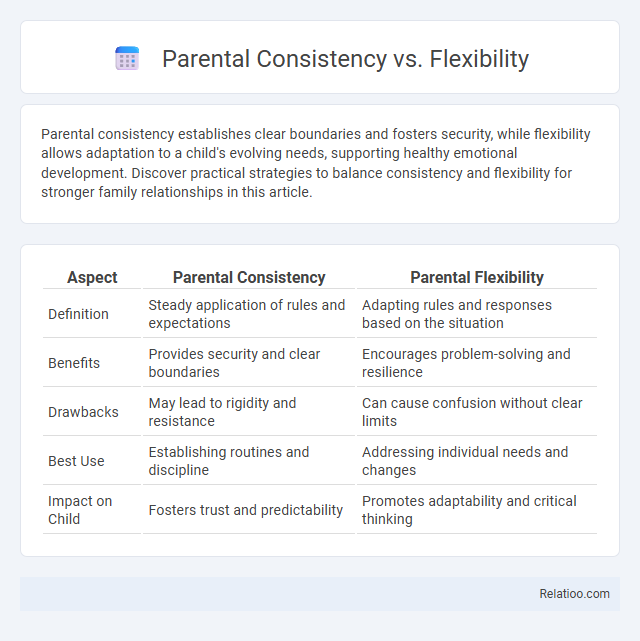Parental consistency establishes clear boundaries and fosters security, while flexibility allows adaptation to a child's evolving needs, supporting healthy emotional development. Discover practical strategies to balance consistency and flexibility for stronger family relationships in this article.
Table of Comparison
| Aspect | Parental Consistency | Parental Flexibility |
|---|---|---|
| Definition | Steady application of rules and expectations | Adapting rules and responses based on the situation |
| Benefits | Provides security and clear boundaries | Encourages problem-solving and resilience |
| Drawbacks | May lead to rigidity and resistance | Can cause confusion without clear limits |
| Best Use | Establishing routines and discipline | Addressing individual needs and changes |
| Impact on Child | Fosters trust and predictability | Promotes adaptability and critical thinking |
Understanding Parental Consistency
Parental consistency establishes clear boundaries and predictable consequences, fostering a secure environment essential for a child's emotional stability and behavioral development. Understanding parental consistency helps you create routines that reduce confusion and anxiety, promoting trust and respect between you and your child. Balancing this consistency with flexibility and modeling positive behavior ensures children learn adaptability and empathy while maintaining structure.
Defining Parental Flexibility
Parental flexibility refers to the ability of parents to adapt their discipline and communication strategies based on situational demands and the individual needs of their children. This adaptive behavior balances consistency in values and rules with responsiveness to a child's developmental changes and emotional cues, promoting healthier parent-child relationships. Research in developmental psychology highlights that parental flexibility contributes to positive emotional regulation and social competence in children by allowing room for negotiation and understanding within the family dynamic.
The Psychological Impact of Consistency
Parental consistency establishes clear expectations and boundaries that foster a child's sense of security and trust, essential for healthy psychological development. Your consistent responses help reduce anxiety and behavioral issues by reinforcing predictable outcomes, which supports emotional regulation. Flexibility and modeling complement consistency but cannot replace the foundational role it plays in building resilience and self-discipline in children.
Benefits of Flexible Parenting Approaches
Flexible parenting approaches enhance children's adaptability by allowing parents to tailor responses to individual situations and developmental stages. This flexibility fosters emotional security, encourages problem-solving skills, and supports healthy autonomy by balancing guidance with freedom. Research indicates that adaptable parenting correlates with improved social competence and resilience in children.
Striking a Balance: Consistency vs Flexibility
Striking a balance between parental consistency and flexibility is crucial for effective child development, as consistent rules provide clear expectations while flexibility allows adaptation to your child's evolving needs. Research shows that children thrive when parents maintain consistent boundaries yet adjust approaches to individual situations, promoting emotional security and resilience. Modeling this balance helps your child develop self-regulation and problem-solving skills essential for healthy growth.
Age-Appropriate Strategies for Consistency and Flexibility
Age-appropriate strategies for parental consistency include establishing clear routines and consistent expectations tailored to the child's developmental stage, such as bedtime rituals for toddlers and structured homework times for school-age children. Flexibility involves adjusting rules and responses based on the child's emotional maturity and situational context, allowing for autonomy in adolescence while maintaining boundaries. Modeling consistent behavior with occasional flexibility teaches children adaptive problem-solving and self-regulation skills essential for their social and emotional development.
Common Challenges Parents Face
Parents commonly struggle to balance consistency, flexibility, and modeling effective behavior in their parenting approach. Striking the right level of consistency helps children understand expectations, while flexibility allows adaptation to changing situations and individual needs. Modeling desired behaviors poses challenges when parents face their own stress, making it difficult to demonstrate patience, empathy, or self-regulation consistently.
Expert Opinions on Parenting Styles
Expert opinions on parenting styles emphasize the importance of balancing parental consistency, flexibility, and modeling to promote optimal child development. Consistency in rules and expectations fosters a secure environment, while flexibility allows parents to adapt responses to their child's individual needs and situational contexts. Modeling positive behavior demonstrates effective interpersonal skills, emotional regulation, and problem-solving, which children are more likely to emulate, reinforcing learning through observation.
Real-Life Scenarios: Consistency and Flexibility in Action
Parental consistency ensures children understand boundaries through predictable expectations, while flexibility allows adapting to unique situations like a child's mood or unforeseen events, promoting emotional resilience. Modeling balanced behavior teaches your child problem-solving and adaptability by demonstrating when to uphold rules and when to adjust. Real-life scenarios, such as enforcing bedtime yet allowing exceptions for special occasions, exemplify how consistency and flexibility work together to foster trust and healthy development.
Tips for Achieving Optimal Parenting Balance
Achieving the optimal parenting balance involves setting clear and consistent boundaries while remaining flexible to accommodate your child's unique needs and developmental stages. Modeling positive behavior through your actions reinforces lessons more effectively than words alone, helping children internalize values and social norms. You should prioritize open communication and adaptability to foster a supportive environment that encourages growth and mutual respect.

Infographic: Parental Consistency vs Flexibility
 relatioo.com
relatioo.com